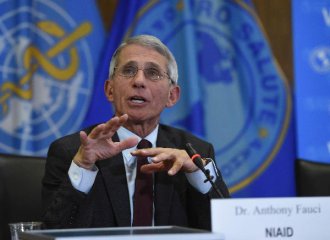WASHINGTON, May 28 (Xinhua) -- New data showed that U.S. economic activity in the first quarter contracted at an annual rate of 5 percent, a downward revision from the previous report. That figure, however, still does not fully capture COVID-19's economic damage, analysts say.
The 5-percent contraction in a second estimate, 0.2 percentage point lower than the advance estimate, marks the biggest quarterly decline since the 2008 financial crisis, the U.S. Commerce Department reported Thursday.
"This report, however, is only a taste of what to expect in Q2, when we forecast GDP to nosedive at an annualized rate of 25 percent," Jay H. Bryson, acting chief economist at Wells Fargo Securities, wrote in an analysis.
Bryson also noted that weak U.S. production and personal consumption weighed on corporate profitability in Q1, but as with GDP, the second quarter will be "much worse" for corporate profits.
The decrease in real GDP in the first quarter reflected negative contributions from personal consumption expenditures, private inventory investment, nonresidential fixed investment, and exports that were partly offset by positive contributions from residential fixed investment, federal government spending, and state and local government spending, according to the report released by the Commerce Department's Bureau of Economic Analysis.
With the second estimate, a downward revision to private inventory investment was partly offset by upward revisions to personal consumption expenditures and nonresidential fixed investment, the report showed.
"Stay-at-home" orders issued in March and other measures in response to the COVID-19 outbreak led to rapid changes in demand, as businesses and schools switched to remote work or canceled operations, and consumers canceled, restricted or redirected their spending, the bureau said.
Jeffrey Sachs, a renowned economics professor at Columbia University and senior United Nations advisor, told Xinhua earlier that the quarterly report "caught just the final days" of March after the U.S. lockdown.
Echoing Bryson's view, Sachs said the decline in the second quarter will be "much deeper."
The revised GDP data came on the same day as the U.S. Labor Department reported that another 2.1 million Americans filed for jobless claims last week, bringing the 10-week total to more than 40 million.
"The rate of decline in initial claims has slowed dramatically, and 2.1 million layoffs in a single week remains tragically and almost unbelievably high," Tim Quinlan, a senior economist at Wells Fargo Securities, wrote in an analysis.
The reopening of the country, and likely also the Paycheck Protection Program, which offers loans for small businesses, appear to be driving employers and workers back together again, Quinlan noted.
The U.S. Federal Reserve, however, said in its latest Beige Book released Wednesday that "contacts cited challenges in bringing employees back to work, including workers' health concerns, limited access to childcare, and generous unemployment insurance benefits."
Earlier this month, the Labor Department reported that U.S. employers cut a staggering 20.5 million jobs in April, which erased a decade of job gains since the global financial crisis and pushed unemployment rate to a record 14.7 percent.
Federal Reserve Chairman Jerome Powell recently said the unemployment rate could peak around 20 percent or 25 percent, and the U.S. economy could shrink dramatically in the second quarter, at an annualized rate of more than 20 percent or 30 percent.
Amid mounting economic pressure, U.S. states -- many without seeing a significant downward trend in COVID-19 infections -- have started to fully or partially reopen their economies since late April. As of last week, all states had already been in some phase of reopening.
Many governors, with the support of the Trump administration, have been scrambling to rescue the devastated economy, but public health experts, as well as economists, have expressed their grave concern that a hasty reopening could trigger a second wave of infections.
"If we get a second wave, it will be a depression," Mark Zandi, chief economist of Moody's Analytics, told CNBC in a recent interview, defining the depression as 12 months or more of double digit unemployment.
"We may not shut down again, but certainly it will scare people and spook people and weigh on the economy," Zandi said.




















Latest comments